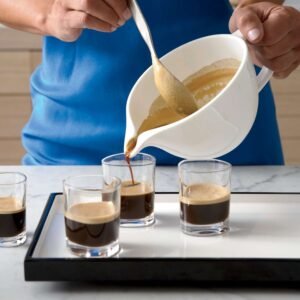Creating barista-quality espresso drinks at home is a satisfying way to enjoy café-style beverages without leaving your kitchen. With the right equipment, high-quality ingredients, and a little practice, you can master the art of making your favorite espresso drinks. This guide will walk you through the steps to make six popular espresso drinks: Espresso, Americano, Latte, Cappuccino, Macchiato, and Mocha.
Equipment Needed
Before diving into the recipes, ensure you have the following equipment:
- Espresso Machine: A good-quality machine with a steam wand.
- Coffee Grinder: A burr grinder for consistent grind size.
- Milk Frothing Pitcher: For steaming and frothing milk.
- Tamper: For evenly tamping the coffee grounds.
- Scale: For accurate measurement of coffee and water.
- Thermometer: For checking milk temperature.
- Espresso Cups and Mugs: For serving your drinks.
Ingredients
- Freshly Roasted Espresso Beans: High-quality beans are crucial for great espresso.
- Filtered Water: To ensure pure and clean taste.
- Milk: Whole milk is preferred for a rich texture, but you can also use non-dairy alternatives like almond, oat, or soy milk.
- Sweeteners and Flavors: Sugar, syrups (vanilla, caramel, chocolate), and other flavorings as desired.
1. Espresso

Ingredients:
- 18-20 grams of espresso beans
Instructions:
- Grind the Beans: Grind 18-20 grams of espresso beans to a fine consistency, similar to table salt.
- Prepare the Portafilter: Add the ground coffee to the portafilter and use the tamper to press it down evenly with about 30 pounds of pressure.
- Brew the Espresso: Insert the portafilter into the espresso machine and start the brewing process. Aim for a shot time of about 25-30 seconds to yield 1-2 ounces of espresso.
- Serve: Serve the espresso immediately in a pre-warmed espresso cup.
2. Americano
Ingredients:
- 1 shot of espresso (1-2 ounces)
- 6-8 ounces of hot water
Instructions:
- Brew the Espresso: Follow the steps to make a shot of espresso.
- Add Hot Water: Fill a cup with 6-8 ounces of hot water.
- Combine: Pour the espresso shot into the hot water.
- Serve: Serve immediately.
3. Latte
Ingredients:
- 1 shot of espresso (1-2 ounces)
- 8-10 ounces of milk
Instructions:
- Brew the Espresso: Make a shot of espresso and set it aside.
- Steam the Milk: Pour 8-10 ounces of cold milk into the frothing pitcher. Insert the steam wand into the milk, just below the surface. Turn on the steam and stretch the milk by keeping the wand near the surface until it reaches about 100°F. Then submerge the wand deeper and continue steaming until the milk reaches 150-155°F.
- Pour the Milk: Pour the steamed milk into a cup, holding back the foam with a spoon. Add the espresso shot.
- Top with Foam: Spoon a small amount of milk foam on top.
- Serve: Serve immediately.
4. Cappuccino
Ingredients:
- 1 shot of espresso (1-2 ounces)
- 4 ounces of milk
Instructions:
- Brew the Espresso: Make a shot of espresso and set it aside.
- Steam the Milk: Pour 4 ounces of cold milk into the frothing pitcher. Steam the milk similarly to the latte, but aim for more foam and less liquid milk.
- Combine: Pour the steamed milk and foam over the espresso, aiming for a 1:1:1 ratio of espresso, steamed milk, and milk foam.
- Serve: Serve immediately.
5. Macchiato

Ingredients:
- 1 shot of espresso (1-2 ounces)
- 1-2 teaspoons of steamed milk
Instructions:
- Brew the Espresso: Make a shot of espresso and set it aside.
- Steam a Small Amount of Milk: Steam a small amount of milk, focusing on creating foam.
- Top the Espresso: Spoon a dollop of milk foam onto the espresso.
- Serve: Serve immediately.
6. Mocha
Ingredients:
- 1 shot of espresso (1-2 ounces)
- 8 ounces of milk
- 1-2 tablespoons of chocolate syrup
- Whipped cream (optional)
Instructions:
- Brew the Espresso: Make a shot of espresso and set it aside.
- Steam the Milk: Steam 8 ounces of milk, similar to the latte method.
- Add Chocolate: Pour 1-2 tablespoons of chocolate syrup into a cup. Add the espresso shot and stir to combine.
- Pour the Milk: Pour the steamed milk into the cup, holding back the foam with a spoon. Top with a small amount of foam.
- Garnish: Add whipped cream and an extra drizzle
FAQ
1. What kind of espresso machine should I use at home?
Answer: The type of espresso machine you choose depends on your budget, space, and how hands-on you want to be. Here are a few options:
- Manual (Lever) Machines: These require the most skill and control but can produce excellent results. They’re best for experienced enthusiasts.
- Semi-Automatic Machines: These offer a good balance between control and convenience. You grind the coffee, tamp it, and start the extraction process manually.
- Automatic Machines: These machines automate much of the process, including the extraction, making them more user-friendly but with less control over the final product.
- Super-Automatic Machines: These are the most convenient, automating grinding, tamping, extraction, and milk frothing. They’re ideal for those who want ease of use without compromising on quality.
For beginners, a semi-automatic machine is a great starting point as it provides a good balance of control and ease of use.
2. How important is the grind size for making espresso?
Answer: The grind size is crucial for making a good espresso. Espresso requires a fine grind, similar to table salt, because the high pressure and short extraction time need maximum surface area for proper flavor extraction. If the grind is too coarse, the water will pass through too quickly, resulting in weak and under-extracted coffee. If it’s too fine, the water will pass through too slowly, causing over-extraction and bitterness.
To get the right grind size, invest in a burr grinder, which provides a consistent grind compared to blade grinders. Adjust the grind setting based on the taste of your espresso—if it’s too sour, make the grind finer; if it’s too bitter, make it coarser.
3. What milk should I use for frothing, and how do I get the perfect froth?
Answer: Whole milk is typically preferred for frothing because it has the right balance of fat, protein, and sugar, which helps create a rich, creamy texture. However, you can also use non-dairy alternatives such as:
- Almond Milk: Nutty flavor and can froth well, but tends to separate more quickly.
- Oat Milk: Creamy and froths well, making it a popular non-dairy choice.
- Soy Milk: Froths decently and has a thicker consistency.
- Coconut Milk: Adds a tropical flavor and can create a good froth but may be thicker.
Steps for Perfect Froth:
- Fill the Pitcher: Fill your frothing pitcher with cold milk up to about one-third full.
- Position the Steam Wand: Place the steam wand just below the surface of the milk.
- Stretch the Milk: Turn on the steam and allow the milk to stretch by keeping the wand near the surface until it reaches about 100°F, creating microfoam.
- Heat the Milk: Submerge the steam wand deeper and continue steaming until the milk reaches 150-155°F.
- Tap and Swirl: Tap the pitcher on the counter to break any large bubbles and swirl the milk to integrate the microfoam for a silky texture.
4. How do I make a good espresso shot?
Answer: Making a good espresso shot involves several key steps:
- Measure the Coffee: Use 18-20 grams of freshly ground coffee.
- Grind the Beans: Grind the coffee to a fine consistency.
- Prepare the Portafilter: Add the ground coffee to the portafilter and distribute it evenly. Use a tamper to press down the coffee with consistent pressure (about 30 pounds of force).
- Brew the Espresso: Insert the portafilter into the machine and start the extraction process. Aim for a shot time of 25-30 seconds to yield 1-2 ounces of espresso.
- Serve: Serve the espresso immediately in a pre-warmed cup to maintain its temperature and flavor.
5. What are some common mistakes to avoid when making espresso drinks at home?
Answer: Here are some common mistakes and how to avoid them:
- Using Stale Beans: Always use freshly roasted beans and store them properly in an airtight container to maintain their freshness.
- Incorrect Grind Size: Ensure you have the correct grind size for espresso. Too coarse or too fine can ruin the shot.
- Inconsistent Tamping: Apply consistent pressure when tamping the coffee grounds to ensure even extraction.
- Improper Milk Frothing: Avoid overheating the milk. Ideal frothing temperature is between 150-155°F. Practice achieving microfoam for a smooth texture.
- Dirty Equipment: Regularly clean your espresso machine, grinder, and frothing pitcher to prevent old coffee residue from affecting the flavor.
Conclusion
Mastering the art of making barista-quality espresso drinks at home takes practice and attention to detail. By choosing the right equipment, using high-quality ingredients, and following precise techniques, you can enjoy delicious espresso beverages without leaving your kitchen. Remember, practice makes perfect, so don’t get discouraged if it takes a few tries to get everything just right. Happy brewing!



